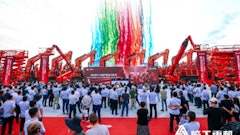
The proliferation of attachments for skid-steer and compact track loaders makes them very versatile pieces of equipment, capable of doing a host of different tasks - including digging a trench. A backhoe attachment mounted to a skid-steer or compact track loader can, in some cases, be more efficient than a dedicated digging machine such as a backhoe-loader.
The backhoe-loader will likely never be replaced by an attachment. That's in part because a dedicated machine is built and designed to do a particular task, and to do that task most efficiently and productively day in and day out.
"A dedicated machine is clearly designed for optimized backhoe performance, from the structures of the mainframe to the hydraulic pump and valves," says Kevin Hershberger, Caterpillar. "An attachment backhoe is one of many tools that are designed to work as well as possible within the limitations of the machine's existing design."
To identify if a backhoe attachment is suitable for your customer's tasks, you need to assess the type of work they typically do, suggests Hershberger. Ask them if trenching is an occasional application or a frequent occurrence.
"Someone who needs to do backhoe work everyday will be better suited with a dedicated machine," says Ron Peters, CE Attachments. "A contractor who digs a trench periodically can use a skid-steer loader."
Also take into account other criteria: any size restrictions existing on most jobs; typical ground conditions and trenching specs; and transportation requirements.
Before pairing your customers with a backhoe attachment/skid steer combo or offering them a dedicated machine, here are some things to consider.
Space concerns
A skid-steer or compact track loader can offer some differences in maneuverability due to their typically smaller size.
"A shorter overall length makes it easier to maneuver around a jobsite," says Justin Odegaard, Bobcat. "If all your customer is doing is digging, there may not be an advantage. But if they're doing everything, such as trenching, backfilling, etc., having a shorter machine can get them into tighter areas." Therefore, a skid steer and backhoe attachment would be ideal.
A skid-steer or compact track loader can also have an advantage in tight spaces due to its steering style. "Maneuverability in general is easier," says Odegaard. "With a dedicated machine, you have front-wheel- or all-wheel steer. With a longer package, it can be more difficult to get into tighter areas. With a skid-steer or compact track loader, you can wiggle yourself into some pretty tight areas."
Soil condition considerations
A backhoe attachment gives operators the ability to utilize tracks. Compact track loaders especially can tread lightly on many jobsites.
"That can make a big difference depending on where they're working," says Odegaard. "If they're in sand or mud, it can be beneficial to have tracks."
Tracks can also have an advantage for working in established areas. "Compact track loaders have a lighter footprint and lower ground pressure so they don't mark the ground up as much. They don't leave ruts in sod if it's soft," Odegaard adds.
How deep do they need to go?
If your customer needs a shallow, narrow trench, the application might be better suited to a backhoe attachment. For example, on some of Bobcat's smaller machines, you can use a backhoe that digs to a depth of 6 feet with a skid steer as narrow as 36 inches.
"If they're digging shallow and need to get into a backyard to dig a fish pond or similar task, they can do that easily with one of our smaller machines because it can fit through the gate and they don't have to take down any fences," says Odegaard.
Hauling machine
A skid-steer loader will typically weigh less than a dedicated backhoe-loader. That weight difference is something to consider, since the additional weight of the backhoe-loader may require a larger trailer and a CDL.
"With the shorter length of a skid-steer loader, you might be able to get by with a little shorter trailer," says Odegaard.



















